Today I’m answering some questions sent in last week – I think this will be a fun and interesting regular feature for the site. If you have a question you’ve been wondering about, please email it to me, and I’ll see if I can get you an answer for the next Reader Questions column! I did get many more than I have the space to answer for this week, so I picked a couple to cover. We start with this email from Bill:
Question #1 – Large brass artillery shell casing
I acquired this some years ago (~15) at a yard sale for $20. It looks like a giant brass cartridge case. It’s dimensions are:
Overall Length 9 1/8″ = 233.8 mm
Case ID 8 1/2″ = 213.0 mm
Case OD 8 11/16′ = 218.0 mm
Rim OD 9 1/4″ = 230.5 mm
Rim Thickness 7/32″ = 6.0 mmThe headstamp around the tapped primer hole reads at:
11:00 & 1:00 3SP 89
9:00 & 3:00 MAI O 1918
6:00 SP 197I have had suggestions that this was for a howitzer but the case seems to be short for that application. A large mortar is another possibility. There was however a uniquely obituration system called semifixed ammunition. This involved a projectile loaded followed by bagged charges. But rather than a DeBang pad the breach was sealed with a short brass cartridge containing the ignition system. My best guess is that this is a 210 mm case for one or another of the guns used in that caliber. Coastal rifles, howitzers, or “sniping” artillery are likely candidates. So what is the opinion of the panel? FWIW it has been my office wastebasket for years! Bill
I consulted with my friend Ira Sellars, and we were able to pinpoint what this case is from, Bill. It’s a case for a Krupp 21 cm Mörser 10/16 – a German heavy mortar used in large numbers during WWI. You can find a hole bunch more information on it from the Kaiser’s Bunker web site. It’s an impressive piece, firing a 252-pound explosive projectile out to a maximum range of nearly 6 miles.
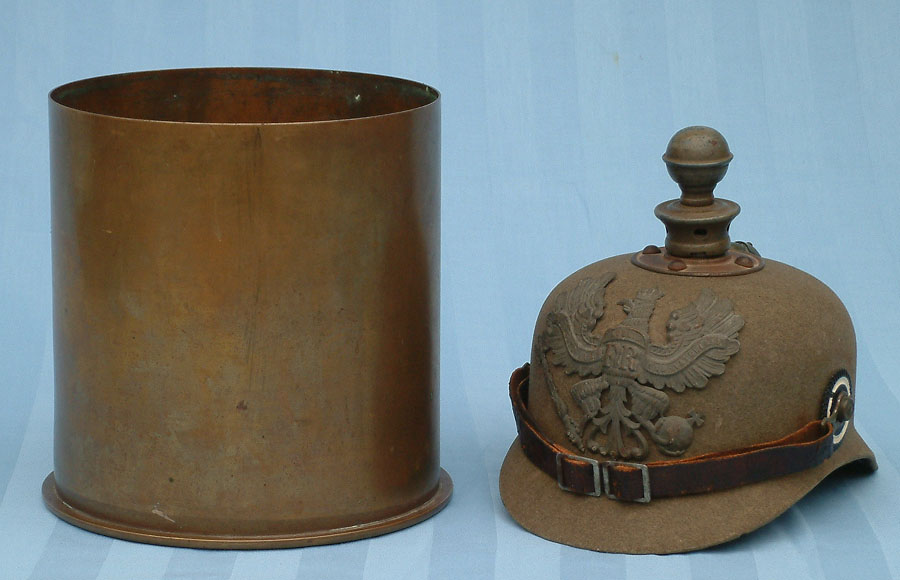
Question #2 – Colombian Mausers
I have a FN Model 1950 Short-Rifle (I think). It is chambered in 30-06 (marked “.30” on the receiver ring). I bought it for $90 in a pawnshop when I was 18, in 2000. This may have been a conversion from the previous FN contract rifles that went to Colombia chambered in 7.65 Mauser. I have found very little information about it’s possible uses in wars, and almost no way to tell if it was a conversion model or was a later contract (try finding serial numbers on these!). It was apparently import marked “.30-06 SPR SPN PN RA PA” on the bottom, which I didn’t notice for many years, and it may be chrome-lined (which I just noticed). Is there any way to find more info on one of these? Thanks – Matthew.
As you say, Matthew, Colombian Mausers in .30-06 were both bought new from FN in Belgium and also converted from older rifles. Both types will be marked “.30” on the rear receiver ring. Probably the easiest way (although not foolproof) to determine whether one is original or converted is the buttplate. An older converted rifle will have a typical flat buttplate. The new ones purchased in the 1950s from FN have a buttplate that wraps around about the back 1/4 inch of the stock, like this:
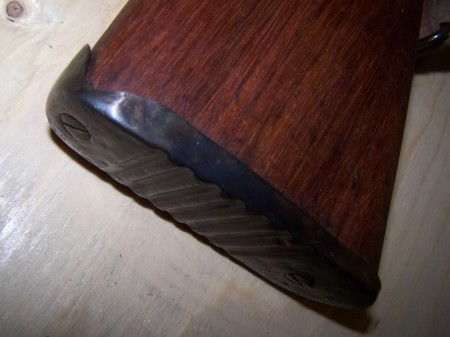
In addition, the side of the front receiver ring will have a Belgian proof that looks like a pillar on a stepped pedestal. That proof mark is a more definitive assurance of the rifle being original Belgian .30-06 production, since the buttplate could theoretically be swapped out. The best discussion I have found on these rifles is this thread at Milsurps.com.
FYI, Colombia bought .30-06 Mausers in both Short Rifle (22.75″ barrel) and Carbine (17.5″ barrel) configurations. The Short Rifles are much more common, and have straight bolt handles. If you come across one with a shorter barrel and (matching) bent bolt, it could very well be an original Carbine version, and not a sporter.
The import markings on the barrel of yours stand for Springfield Sporters, Penn Run, Pennsylvania – they brought in a bunch of these guns in the 1960s.
Colombia has not been involved to any significant extent in any international wars where these Mausers could have been used, but it has had a lot of internal strife, including a 10-year civil war from 1948 to 1958 (“la Violencia”) in which the .30-06 Mauser rifles may well have seen use. There is no real way to determine the history of a specific rifle short of having something like stock art on the gun or a traceable lineage on the weapon (which would not be the case with one imported as part of a Springfield Sporters batch).
Question #3 – Identifying dredged-up pistols
From Bart, we have this photo of the remain of four pistols fished out of a Dutch canal during a dredging operation – and he wants to know if we can identify any of them.
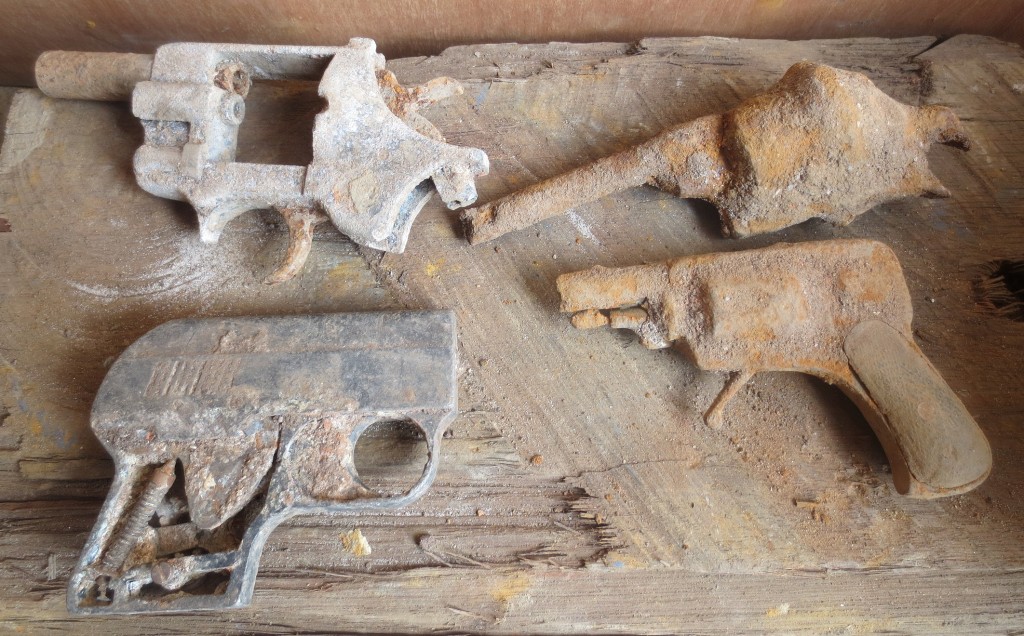
Well, Bart, I thought I would be able to find something on the lower left automatic, but my searching turned up nothing that matches. However, I am pretty sure that it is a blank-firing starter pistol – the exposed nub of the hammer is a feature fairly common in starter pistols and pretty rare in defensive pocket pistols.
The lower right revolver is of the “Velo-Dog” type, although I can’t tell a specific make or model (there were lots of these type of pistols made by small shops) under all the corrosion. These were .22 and .25 caliber revolvers with folding triggers and shrouded hammers intended basically for bicyclists to use on overly-aggressive dogs. Or for anyone else who simply wanted a very small and concealable handgun.
As for the two revolvers on top, I have no idea. The left one is more intact, and perhaps one of our readers may recognize some of the features and be able to determine the make and model…
Question #4 – Israeli translation
WHAT DOES DROR MEAN ?
We’ll finish up with a quick one from Gary – “Dror” in Hebrew can mean either “sparrow” or “freedom”. In the case of the Dror LMG, I think it’s a safe bet that “freedom” was what they had in mind. (Thanks to Amit for the translation!)
I hope you found these interesting! If you have a question you would like to have addressed next week, send it to me!

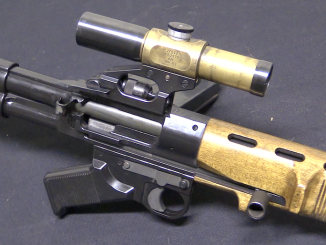
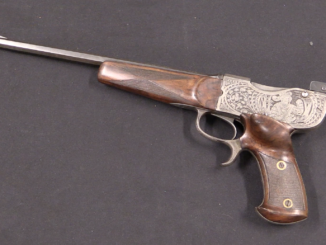
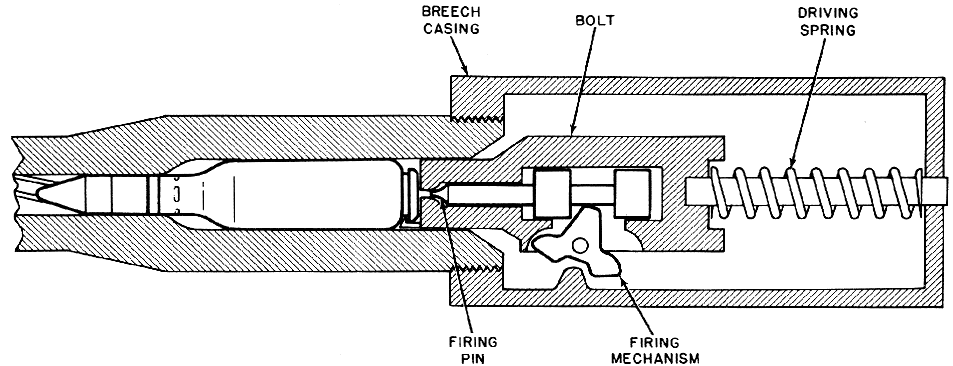
Top right looks like it use to be a PinFire revolver. Bottom left looks like a good candidate for electrolysis.
~B
Is there any legal definition of when ca firearm is no longer a firearm and just a relic? At least 3 out of 4 of these are obviously no longer guns, but there are many that fall into a gray area.
The automatic in the bottom left hand corner could be a starting or gas pistol.
No evidence of a magazine well.. If the muzzle has a square hole below the “barrel” that is what it probably is..
The starter pistol in the LLH corner of the Question 3 photo could have sold by several different German firms. Walther ‘made’ it as the Model UP.1, which was imported by Interarms in the mid 1960’s. Thalson, an early post WW II importer of Wather firearms to the USA also sold a version under their own name, not Walther’s. Haenel, RG and others also marketed this starter pistol under their names in Europe.
Its receiver is die cast zinc, which is difficult to restore. The steel ‘harmonica’ style magazine holds 6mm (.22 RF) rimfire blanks pointed vertically and they discharge at a 90 degree angle into the ‘barrel.
@P161911: law in the Netherlands states that these items should be considered as ‘Weapons and ammunition’ (Wet Wapens en Munitie), which means they have to be collected by EOD. This is what actually happened in this case: the guns (or what’s left of them) have been collected by EOD and probably destroyed, together with the dredged up ammunitions. There might be a different kind of approach when the items are found on archaeological excavations, but I have no knowlegde of that part of the law.
As for Belgium: legally, when finding any kind of gun, one must contact local police officers, but I doubt that ever happens. Same with ammunitions (especially around WW1 sites), one must contact local police officers. They in turn contact DOVO (EOD) to collect the ammunitions. But when a gun in that sort of condition is found on an archaeological excavation, it is considered to be a relic. Ammunition from WW1 sites is much debated: archaeologists consider ammunitions as relics, but in fact they present a safety danger, so they are collected and destroyed by DOVO. Now I have no idea what would happen if a fully functional gun emerged from the blue clay of Ypres. There have been known examples, but I don’t know where those guns ended up.
The remainder of the revolver in the top left corner looks pretty much like an Arminius revolver. Those were built in all kinds of models: blank firing starter guns, cal. 4M20 ‘gallery shooters’, .22lr up to .38 Special, some even .357 Magnum. The blank firers and small bore usually had zinc cast frames and steel ‘barrels’, cylinders, hammer and trigger parts.
Characteristically, to swing out the cylinder you had to pull the cylinder axis / ejector, which protruded from the crane, to the front to disengage from the frame. Later models had a S&W-like push-lever on the left side of the frame, behind the cylinder.
I can’t make it out very clearly, but there seams to be a horizontal block in the barrel, which hints that this once was a starter gun.
As for the “automatic” beneath it: my guess is on an Röhm RG3, since the Walther UP look a little ‘slimmer’/more streamlined than the one in this picture. But it could well be one of the many other manufacturers product, following the same basic design.
…and the link to a photo of the Arminius .22 lr variant: http://www.imfdb.org/images/2/22/ArminiusC.jpg
they have one of those Krupp 21 cm Mörser 10/16 in fall river,MA at kennedy park.
The starter pistol on the left bottom should have a hole on top. This is were the gas escapes. Look like there is also a pinfire revolver in the picture with the folding trigger.
Not necessarily. There are a lot front firing models from different manufactureres (more than top venting, actually). They used to be called “vineyard guns”, to launch pyrotechnical loads (flash-bangs, so to say…) via a srew-on adaptor in order to repell birds trying to feast on the grapes…
That particular model has a false “muzzle” in front above the squarish hole for the “harmonica” magazine. It should be blocked by cast-in crossbars like a “plus” sign- + – to prevent any attempt to insert a projectile of any kind.
I had one of these that I picked up for $2 once. I used it to train dogs not to freak at the sound of gunfire.
cheers
eon
Thought at first the “automatic starter pistol” on the lower left was a C.O.P. Checked an image:
https://www.google.com/search?q=C.O.P.+gun&client=firefox-a&hs=jQg&rls=org.mozilla:en-US:official&channel=sb&biw=2366&bih=1157&tbm=isch&imgil=CqRexAixnWfAtM%253A%253Bhttps%253A%252F%252Fencrypted-tbn2.gstatic.com%252Fimages%253Fq%253Dtbn%253AANd9GcTStFnV1A7IVaPWnS7n0DtWiorP4gT3qlASL6-5MzNdUYYNjWtE-Q%253B640%253B480%253BPnkD6wxqupSKbM%253Bhttp%25253A%25252F%25252Fwww.ja-galaxy-forum.com%25252Fboard%25252Fubbthreads.php%25252Ftopics%25252F288665%25252F5%25252FAIMNAS_Item_requests.html&source=iu&usg=__xd8-Bv9ld-Mg0l5wvY3uEu4IuEQ%3D&sa=X&ei=odApU52QO8yYqAHqpoDQCg&ved=0CC8Q9QEwAQ#facrc=_&imgdii=_&imgrc=CqRexAixnWfAtM%253A%3BPnkD6wxqupSKbM%3Bhttp%253A%252F%252Fwww.arniesairsoft.co.uk%252Freviews%252Fmarushin_cop357%252Fphotos%252Fcop-02.jpg%3Bhttp%253A%252F%252Fwww.ja-galaxy-forum.com%252Fboard%252Fubbthreads.php%252Ftopics%252F288665%252F5%252FAIMNAS_Item_requests.html%3B640%3B480
Too many differences.
Lower left pistol, anyone considered a pepper box like the Mossberg Brownie?
This was a good idea, Ian. Keep it up!
I suspect the top left revolver is a RG (Rohm Gesellschaft). The barrel, trigger and hammer show red rust because they’re steel while the frame has white powdery corrosion as you’d expect from zinc alloy.
Many of the swing out cylinder models of the RG had a notch cut into the cylinder backplate. That one in particular looks like the RG23 (.22LR) however the RG56 (blank) and the RG38 (.38 spl) all have similar frames.
I’m afraid this is not an RG (although the “automatic” benath it most probably is).
As a reference, look at this photo: http://www.imfdb.org/images/2/22/ArminiusC.jpg
I think the notch for the cylinder lock, the configuration of the barrel and the cast rear “sight” on top of the frame give it away as an Arminius.
I also believe it is an Arminius. Besides what Michael has pointed out, the barrel looks to be in the same place. Also the pin or screw for the hammer looks to be in the same place on both.
I second MikeyM’s post. Enjoyable. The number of knowledgable people who contribute here is always impressive.
Aw, crap, I really wanted the upper right to be a vintage Belgian Bulldog. Reading the comments from those who know more than I do, it is probably a 1960s RG. But of all my favorite “forgotten weapons” I’ve got a soft spot for the Bulldog. The Webley original and the Iver Johnson American clone are the best, but some of the Belgian copies are decent. (Note: the Bulldog was a “concealable cantaloupe” Brit double-action revolver with solid frame and SAA-style loading gate/ ejector rod, in a variety of short .44 and .45 rounds.)
Question about RG: somewhere I read that in the late 60d Herter’s switched single-action revolver supplier from J. R. Sauer and Sons (one of the best deals you will find at a gun show, either in .357 or the really obscure .401 Herter’s) Did Herter’s switch from Sauer to RG, with a huge drop in quality, for a few years before they went under?
Re: the Velo-dog type revolver on bottom-right, I’d say it was an F.A. by “Francisco Arizmendi” of Eibar. Wouldn’t bet any vast sums of money on it though.
And I think Mr Schumacher has it correct with a latter-day Arminius revolver on top-left.
The revolver at top right is almost certainly a pin fire, and at a glance, superficially resembles a Belgian W1198.
Handguns left to right(Top); HW Arminius zamak frame revolver, 1870 Montenegrin
Gasser patern revolver of Belgian or Austria origin.
Handguns left to right(Bottom); Walther pattern zamak frame blank pistol, Belgian
Lapage pupy revolver or copy of Spanish or another Belgian makers.
Way too small for Gasser, those things are monsters.
Right. But the blank pistol at below left seems rather bigger than the actual
size when compared with Arminius and all the scene looks, as if the angle of
objective distorted some dimensions.
Lower left pistol looks strongly like a Röhm RG3 blank firing pistol:
http://www.militaria.pl/upload/wysiwyg/gfx/produkty/samoobrona/Pistolet_hukowy_Rohm_RG3_708.02.00/pistolet_hukowy_Rohm_RG3_708.02.00.jpg
I had one of these “starting pistols” when I was posted in Germany in the ’70s. They were sold as “knall” or “Gas” pistols and had a “through” barrel, although the blank fired at right angles to the “barrel”.
There was a wide range of ammunition available for these guns. In addition to the standard .22 RF Blank, there was a Gas cartridge containing CN tear gas. These were very popular with German Taxi drivers..
You could also buy a screw in discharger cup which would fire coloured flares, rockets, and a particularly spectactular air burst maroon, presumably designed for bird scaring, however worked well on other species as well 🙂
I love these “I have this old gun (or old gun stuff)” type feature. More please!
http://www.icollector.com/Finely-Engraved-Gold-Inlaid-European-Folding-Trigger-Double-Action-Revolver-with-Rare-Black-Pearl-Gr_i13752017
Lower right hand revolver, check the trigger and grip shape for example. Looks like perhaps a shorter barrel on the rusty specimen?
Starting pistol shape and internals look to me like a German-made EM-GE staring pistol which fires 6mm rimfire blanks. Had one myself and you can still buy them.
Hey Ian:
What is the best way to get in contact with you?
Ian,You may want to do a video on the Russian WWII Spade Mortar.The Manager of Sarco Inc.formally the Manager of IMA-USA and the Owner of Kamabee Keep, Mark Dotten had Me craft a Non-firing Replica for mass reproduction overseas.If You send Me a email address I’ll send You pictures.Sarco’s has been selling this 37mm Entrenching Tool/Mortar for 3 years now.There is a Wiki article on it.Along with some Google Images.
Ian, I have just watched your episode re the E German SKS. You mentioned the lack of butt stock trap to hold the standard tube pattern of cleaning kit and the lack of a cleaning rod. I think this is because the E Germans used a cleaning kit similar to the RG 36 but about half the size.. Similar sheet steel case with a hinged lid and the usual pull through and AK type tools.. These were contained in a dark grey pouch that wrapped round the case.. I have two more f these, one for 7.62 and one for 5.45 rifles. They are too big to store in the butt trap and the rod is replaced by the string pull through. When you’re next in the UK happy to meet and show you of you want?
DROR – sparrow
Ian, i came across i semi auto hammer less pistol. The owner believed he had a Early beretta pistol. Serial # 126
After he sent me pics and doing research – his grips are metal Beretta PB but the pistol i don’t believe is. There is no markings or stamps. The pistol is nickel and shoot .32 cal. I believe he might have a Ruby or a Ruby copy. It has a safety at the back of the grip left side. I do have pictures which i can send you. I’m just trying to identify for him. Maybe give him a little back ground on it since he did acquire it 50 years ago. If you have a email i can send you the pics that would be good. Just need someone that can identify it.
Ian,
How were rounds transferred from a machine gun belt to the chamber before the disintegrating belts?
Dave